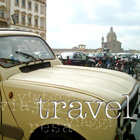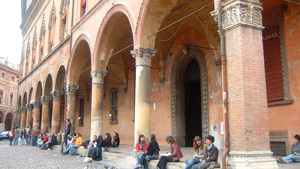
|
EUROPE'S 1ST UNIVERSITY & A SPIRIT OF PERSEVERANCE 28 April 2006 :: Lainey Johr Less well-known than nearby Tuscany with its myriad of famous hillscapes and medieval towns, the region of Emilia Romagna to the east boasts its great and complicated capital: Bologna. A town known for hearty cuisine and a leftist politics, Bologna is full of things to see and do apart from eating. It is an under-toured historical city, ripe for rich days of discovery. Bologna’s maze of porticoes is so extensive, it could easily be imagined shielding many a Bolognese from getting wet on the way to mass in one of the many churches dotting the landscape. A visitor quickly develops the impression that every corner of the town is laced with porticoes, splashed with the Italian sun that pours over them, giving Bologna a unique visual character. In fact, there is no town with more covered walkways in the world it seems, for they are indeed everywhere. The oldest date to the 12th century. Altogether, the portichi spread across the city with an astonishing 70 km of arched walkways. Still one of Italy’s best-kept secrets, Bologna has much to offer at a relatively low tourist rate, even during the high season. The city center is ideal for walking and exploring hidden histories as you go. Surrounding the Piazza Maggiore and the Piazza del Nettuno, and radiating eastward from its center, the city’s historical and cultural delights abound. Along old cobbledstreets, many closed to all but the ruckus of foot traffic, you will find most of the city’s best preserved medieval treasures. Inside this antique city you will find architectural gems like Bologna’s two towers, which at least one writer has labeled the ‘Laurel and Hardy’ of medieval architecture. These towers, like their famous neighbor in Pisa, do indeed lean, and they lean toward one another, so much in fact that in 1360 one of them was chopped in half to save any unlucky passersby from a shower of falling stone! Built originally as watchtowers, locals and tourists alike can scale the 500 plus steps to the top for a marvelous view. If it’s a church you’re after, you are in luck to find a grand example in Bologna. The city’s Basilica di San Petronio is one of Italy’s largest. Its original scale called for one much larger, but plans were curtailed by papal fears of it overshadowing that of St. Peter’s in Rome. The Vatican’s criticism of the great Duomo’s facade in Florence may have spurred the Bolognesi to forfeit finishing the façade of San Petronio. It has never been finished, leaving a rough, utilitarian character. The reason for this is debatable, but similar churches mimic this sense of frugality or fatigued aspirations of the Basilica. Whatever the cause, it seems fitting for a city characterized by its practicality and independence. Bologna boasts one of the best-kept medieval city centers of Italy, which is no small feat. The city’s active passion for preservation is key to their conservational success. The city’s air of ‘active history’ is seen in its bus system, ATC, whose fleet is mostly electric in the center (tickets are pre-purchase at local Tabacchi shops). The city of Bologna was founded by the early Etruscans. Although not a major city under the Etruscans, Bologna (which they called Felsina) remained relatively consistent and stable as regional powers began to center on Rome. In 350 BC the city got its modern name from the conquering Celtic tribe of Boii, naming it Bononia. Soon conquered by the Romans in 189, Bononia remained a small municipium. Under the Exarchate of Ravenna, a foothold of the Byzantine Empire in sixth century Italy, Bologna became a frontier city, fortified against invaders and a target for forces from neighboring regions. The city struggled to resist takeover by the Lombards, but finally fell to Lombard King Liutprand, in 727. The Lombards later lost the city to the forces of Charlemagne in 774. Unlike many other cities around the region and throughout Europe during these Dark Ages, Bologna is thought to have thrived, even expanding past its original boundaries. Bologna hit medieval times with a surge of great enthusiasm, starting Europe’s very first university and forming one of three free comuni. It is also the first city in all of Italy to have sold copies of books, and its intellectual tradition has descended to the present in the form of intense artistic and literary activity, still rooted in that oldest European university. The 1100s saw a robust rise in the city’s ‘skyline’ with as many as 180 new towers being built. Built by the city’s nobles, they shadowed over the city’s newly enlarged population of 50,000 inhabitants, making Bologna one of Europe’s great cities by the year 1200. The coming years saw Bologna grow to six times its original size. Crossed by a series of canals that powered local industry. Soon thereafter, the city fell under Papal control, as an attempt was made to ruin the city’s history as a free comune and impose the papacy’s direct rule in 1327. Even building an imposing fortress, papal representative Cardinal Bertrand du Pouget could not do enough, and was chased out of town by angry citizens in no less than six years. A fight for control over Bologna ensued through the years between the Church and the local signore, as in many other towns during this time. But the city’s big blow came in 1348 with the Black Death that killed a third of the population. And despite efforts and patronage, Bologna had relatively little to contribute to the dazzling artistic movement during the Renaissance. 1506 saw a change in rule for Bologna. For the Bolognesi, sick and tired of the ruling Bentivoglio family, welcomed the conquest of Pope Julius II over the city. Not realizing what they had done, the Bolognesi were soon stripped of independence and freedoms enjoyed since days of old, and power over the city was firmly in the hands of the church. In 1530, Emperor Charles V was crowned Holy Roman Emperor in Bologna’s San Petronio, instead of in Rome's great basilica. This foreshadowed a wilting control over the empire as well as the fall of the early stages of the end for the Renaissance as Charles was also crowned King of Italy. This era saw a newly assertive Papal control following the Council of Trent, and spelled the end of local artistic and intellectual control over the city. The once great university floundered, books were burned and humanist scholars were exiled. 1553 saw the Inquisition ride through Bologna, and with it the Jews were robbed of their money and assets and placed in ghettoes, only to be exiled from the city altogether in 1593. Oddly, this period of oppression coincided with Bologna’s most artistically prolific century, with artists such as Caracci and Guido Reni taking center stage. So many monasteries went up that outsiders remarked that it was a city virtually overrun by religious men, as well as by increasing numbers of homeless. The next two centuries were relatively quiet, without great cause for comment or historical attention. It remained a relatively peaceful place until the 1800s brought the end of papal rule, a railroad as well as the first sense of a united Italy. Twentieth century Bologna can be characterized as independent and politically active, as the city led the country’s socialist movement. Bologna took part in a series of revolts against fascist rule in 1944. Following the war, Bologna’s modern identity as a communist region took its roots under Mayor Giuseppe Dozza. He made infrastructural improvements and socialist programs, making Bologna one of Italy’s most pioneering and functional cities. Later years saw a divide between Bologna’s communist tendencies and a newly conservative-leaning country. In 1977 a riot broke out as police shot a demonstrator, leading to the ‘Anni di Piombo’ or years of lead. During this time, right leaning groups in the police brigade and armed forces gained access to the ‘Red Brigade’ and terrorized the country, trying to bring down democracy, which they derided as inefficient and too tolerant of leftist political ideology. No one is quite sure how this began and who was behind the movement. Instead, there began an attack on communist and other ‘red’ groups including a bus bombing near Bologna that killed 12 people, and assassinating the Prime Minister Aldo Moro, who was supportive of communist inclusion into government. With terror at its peak in 1980, they set off a bomb in Bologna’s Stazione Centrale, wounding over 200 and killing 80. In the 1990s, a decline in the city’s cleanliness and safety (and an increase in crime and drug-use) led the citizens of Bologna to turn toward new, less turbulent leadership and they elected a business-minded, conservative mayor in 1998. This was a clear shift away from radical politics, reflecting the people’s heightening desire for stability and political social order. Many who favored right-leaning political groups across Italy gleefully saw this as the flailing last breaths of the fiery region’s communistic spirit. But Bologna is also center of the region where newly elected Prime Minister Romano Prodi’s center-left coalition of parties has its constituent base. It has an active political life, and is also a place where fashion is neither predictable nor ignored: the high-brow and high-fashion blend seemlessly with the rough and casual in an atmosphere reminiscent of the character history has assigned to the city's people. A brief walk through the center will reveal the city's many charms and its surprisingly intricate fabric. And no visitor should miss the fact that the city still thrives on its hallmark traits: excellent but not extravagant cuisine, a vibrant cultural and intellectual life, the great university, and an instinctive resistance to uniformity or to the end of debate. [s] |
|||||||||||||||||||||
|
||||||||||||||||||||||











